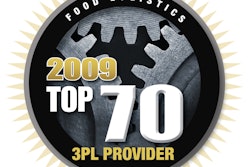It’s counter-intuitive, but true: by adding redistribution as a step in their supply chains, redistribution actually allows chains to consolidate shipments, reduce costs and increase efficiency.
Several quick service (QSR) and casual restaurant giants, including Burger King, Dairy Queen, Denny’s, A&W, Taco Bell and KFC, have met the challenges of today’s tough economy through significant supply chain cost savings using redistribution.
Redistribution is still a concept that’s not widely understood in our industry. The facts bear this out: despite the leadership of chains like Burger King, Dairy Queen and YUM! Brands, nearly 40 percent of the industry’s largest chains have not made the leap to redistribution.
Yet nearly all restaurant chains with established distribution systems—of any size or shape, including mid-sized companies with 500 to 1,500 locations—can benefit. For chains that deal with less than truckload (LTL) shipments and frequent promotions programs, initial cost savings typically run 10 to 40 percent.
It’s important to note that not every product that moves through the supply chain qualifies for redistribution. But three to ten percent of all items that typically move through a food service supply chain do qualify, including slower moving, promotional or seasonal items such as dry or frozen food grade items, janitorial, sanitation and safety items. There are significant savings to be harvested.
As restaurant sales remain sluggish and profits are squeezed at the store level, increasing efficiency and wringing cost out the supply chain is the name of the game—and redistribution is a key advantage.
Supply Chain With Redistribution
Without redistribution, suppliers or manufacturers produce products in their plants and ship them in LTL and truckloads to third-party forward warehouses, company distribution mixing centers, or directly to distribution centers.
With redistribution, manufacturers ship truckload quantities of slower moving, promotional or seasonal items to the redistributor, who ships full—and mixed—truckloads of products to foodservice distributors. The redistributor purchases qualified products from the manufacturer or vendor and ships these items to its own warehousing facilities in truckload quantities. The redistributor then creates full truckload shipments of consolidated SKUs of product to the distributor. This process creates a lower cost of freight and a higher reliability of slow moving or time sensitive in-stock product.
Let’s look at a common item in most chains: straws. Typically the supplier has a minimum amount they will ship, such as two pallets. So even though the distributor only needs a half pallet, or 20 cases of straws, they purchase two pallets, knowing that they must make room in their warehouse to store the extra inventory. The redistributor regularly purchases large quantities of straws and holds them for distributors, to ship at the right time and in the right quantity. This increases the distributor’s inventory turns and controls their costs.
An optimized supply chain network allows franchisors to negotiate with a manufacturer and know that the product will arrive at the restaurant with a reasonable distribution cost markup and the most dependable, lowest freight rates. The redistributor provides reporting to both franchisors and distributors that allows them to determine what their total landed cost should be, by SKU.
Redistribution: A Plus For All Parties
Actually, redistribution benefits all parties of the restaurant supply chain, including the franchisor, the supplier, the distributor and, ultimately, the franchisee.
Saving money is the primary benefit of having a redistributor handle slower moving and promotional products, typically shipments of less than 25,000 pounds per month. Redistributors help reduce inventory levels throughout the system; reduce outdated inventory through centralized management of promotional products; consolidate shipments to reduce LTL shipping costs; and leverage volume purchasing to further reduce product costs to the franchisor.
Additionally, all parties benefit from the single point of contact and communications that the redistributor provides. They also reap benefits of increased data transparency. The franchisor can make one call or check online any time on inventory levels, open purchase and sales orders, and distributor purchase history. The transparency and convenience of this data being in one place also makes brand compliance and preparing contingency plans easier.
And while the franchisor benefits from better communication and reduced costs, a good redistributor can solve one of the franchisor’s most vexing problems: getting the right product at the right time into each franchisees’ distributor by working closely with the suppliers to ensure proper and timely delivery of key items, particularly sensitive seasonal or promotional items.
Suppliers, much like franchisors, also benefit from the cost savings and buying power that redistributors provide. Because the redistributor thoroughly manages the details and is in constant communication with suppliers, suppliers can better schedule production, thereby decreasing their manufacturing cost. Additional cost savings come from shipping to one location instead of many. Finally, administrative costs also are reduced, since only one invoice is generated.
The existing distributor network benefits as well. The redistributors can provide improved communications on inventory, orders and promotional information. Functioning as a consolidation warehouse, the redistributor allows distributors to react to change requests more quickly and efficiently, reducing their own inventory and increasing inventory turns. The distributor also will experience reduced administrative costs by processing a single order, paying a single invoice and receiving a single truck.
By consolidating slower moving and promotional items, enhancing communication and reducing costs at key points in the supply chain, redistributors are an asset for franchisors, suppliers and distributors alike. So if your sales are sluggish and your profits are squeezed, redistribution may be the right medicine, right now, to increase efficiency and reduce costs in your supply chain.
5 Reasons For Re-D
- Significant savings on LTL loads of certain items;
- More transparency, less hidden costs in supply chain;
- Optimized inventory levels throughout system;
- More reliable, on-time delivery;
- A diligent partner to help meet cost-saving objectives.















